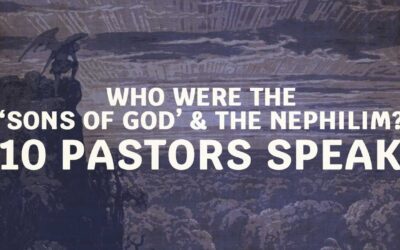
Amazon Prime’s House of David has stirred fresh interest in some of the oldest and most controversial questions in the Bible—particularly around giants, the Nephilim, and Goliath’s true nature.
In Episode 6, titled “Giants Awakened,” the series reveals Goliath and his kin as the last descendants of the Nephilim, born from the ancient union of rebellious angels and human women.
That’s a bold choice—and one that isn’t without biblical and historical backing. But how does it square with the actual text of Scripture? And is this portrayal warranted, or simply imaginative storytelling?
Let’s take a closer look.
The Biblical Nephilim: Who Were They—And Where Did They Go?
Genesis 6:1–4 introduces a strange and compact story: the “sons of God” saw that human women were beautiful and took them as wives. Their offspring were the Nephilim, called “mighty men of old, men of renown.” Most early Jewish and Christian interpreters—including writers like Philo, Josephus, and later church fathers like Irenaeus and Tertullian—understood the “sons of God” as angels, not men. The Book of Enoch and other Second Temple texts expanded this story, portraying the Watchers (fallen angels) as fathers of giants whose violence and corruption filled the earth before the Flood.
But here’s the key detail: Genesis 6:4 says the Nephilim were on the earth “in those days, and also afterward.” That ambiguous phrase is one of the biggest reasons scholars still debate whether the post-Flood “giants” seen in Canaan were connected to the original Nephilim—or simply echoed their reputation.
When Israel’s spies scouted the land of Canaan in Numbers 13:33, they reported seeing “the Nephilim,” and added, “the sons of Anak come from the Nephilim.” Later biblical books (Deut. 2, Joshua 11, 1 Sam. 17, 2 Sam. 21) describe figures like the Anakim, Rephaim, and Goliath’s relatives as unusually large and dangerous warriors. But it’s not always clear whether these groups were biologically related to the Nephilim—or if the label was used more generically to describe intimidating enemies.
What House of David Does with Goliath
In Episode 6 of House of David, the series fully embraces the ancient interpretation of Genesis 6. Goliath is presented not merely as a large man from Gath, but as a living remnant of the original Nephilim—offspring of the angelic Watchers, including Samyaza, who descended to earth and interbred with women. The series even gives Goliath a mythic backstory, linking him to siblings like Lahmi, Ishbi, and Benob, and situating them in a shadowy cave until recruited by King Achish.
This approach “distinguishes itself by fully embracing the supernatural dimensions of Goliath’s backstory,” writes The Bible Artist. It’s a choice that fits the tone of the show, which leans into biblical mythos much like The Lord of the Rings draws from old Norse and Celtic legends.
To be clear, House of David is not claiming that its version is the only possible reading. As co-creator Jon Gunn explained, “We wanted to be careful to tell it as a story, as a myth… because who knows the real answers to this stuff?” Jon Erwin adds that the lore of Nephilim would have been “the conversation around the campfire” in Israel’s early days.
This storytelling decision may feel speculative, but it reflects real historical interpretations—especially from the Second Temple period, when Jewish literature and imagination actively tried to reinterpret pagan myths through a biblical lens.
Is This Portrayal Warranted?
Here’s where perspective matters.
The Bible never directly calls Goliath a Nephilim. But the connections are there, and some scholars believe those connections were intentional. As Christianity Today points out, “The link between Goliath and the fallen angels has a pretty solid biblical basis.” Goliath is from Gath, one of the cities where remnants of the Anakim settled after Joshua’s conquest (Josh. 11:22). His brother Lahmi is explicitly called a descendant of the giants (1 Chron. 20:5). His coat of mail is described with serpentine imagery, which many see as echoing Genesis 3 and the demonic seed motif.
So while Goliath is not definitively labeled a Nephilim, portraying him as part of that ancient story is not unreasonable—it’s one possible way of understanding how his figure fits into the larger biblical theme of cosmic conflict. As Humble Theology explains, these battles weren’t just military—they were “conquest narratives rooted in cosmic geography,” where Israel was reclaiming land from rebellious spiritual powers and their human allies.
That said, the link is still debated. Some scholars argue that the post-Flood giants were unrelated to the original Nephilim, and the reappearance of the word in Numbers 13:33 was the spies exaggerating out of fear. Others believe the Nephilim line survived in some form—perhaps spiritually, culturally, or even biologically. But the Bible doesn’t say exactly how.
Conclusion: More Than Just a Tall Tale
The Goliath of House of David is more than a towering warrior—he’s a symbol of the ancient threat re-emerging in a new generation. That portrayal resonates with some of the oldest Jewish traditions and brings new depth to David’s victory as more than a military win—it becomes a spiritual triumph over a corrupted legacy.
Still, the series’ interpretation is one of several, not a definitive answer. And that’s okay.
We need more portrayals like this: creative yet respectful, speculative yet grounded, willing to wrestle with mystery without claiming to solve it all. House of David gives us a chance to revisit the giants of Scripture not as cartoons or conspiracies, but as part of the Bible’s larger story about rebellion, redemption, and the One True King.
Coming Soon:
The Descent of the Gods — a fictional yet biblically grounded retelling of Genesis 6. Join the waitlist to explore the ancient world of the Watchers and the flood that followed.
Interpretation stance: Angelic (supernatural) view acknowledged as dominant in antiquity, but multiple views noted
Location: Gath, Valley of Elah
Lifespan or Air Date: Episode 6, House of David, March 20, 2025
Source Links:





